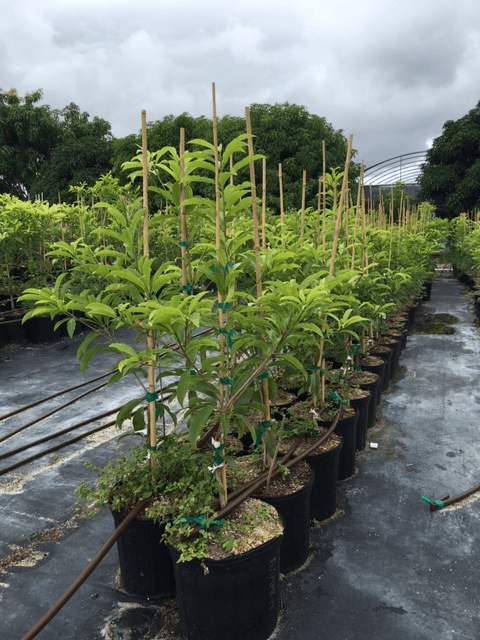Sapodillas trees range in size from 6' tall to as much as 100' in the tropics!
Manilkara Zapota
DAMAGE TEMPS: 30F (zone 10a)
- mature trees have been known to withstand several hours of temperatures at 24-26 degrees, though young trees can be killed at 30 degrees;
- Fruits mature 4-6 months after flowering.
- likes consistent water, but good drainage is essential;
- trees require very little pruning, unless you desire to keep small;
Here's a comparison of the most popular sapodilla cultivars:
SILAS WOODS -- South FL selection;
- Dwarf tree: 6-10' tall; perfect for a container plant;
- mature trees have been known to be cold-hardy to 26F
- ever-bearing, very prolific, heavy bearing;
- small fruit --- 9oz; 2-3" in diameter;
- super sweet: tastes like brown sugar
- fine texture: white flesh;
Thailand varieties
ALANO -- #1 Thailand variety;
(#1 fav on the East coast of FL)
- small tree: 25-30' tall;
- ever-bearing, heaviest production Nov-June;
- small fruit -- 9oz; same size fruit as Silas Woods;
- super sweet / ultra fine texture;
MAKOK -- Thailand variety; new to FL;
- small tree: 20-25' tall; ripens May-Nov;
- one of the best tasting; pulp is smooth & brown w/ a sweet aroma;

3g Sapodilla growing in the nursery

grafted sapodilla will start blooming young

Sapodilla flower just beginning to open
Central American varieties
HASYA -- #1 commercial variety in Mexico
- one of the bigger cultivars: 13oz fruits;
- ripens Nov-June
- elongated / football shaped; has more flesh and less seeds;
- color: yellowish-reddish
- texture: finer texture than Morena;
- a common South FL favorite amongst the Mexican varieties;
MORENA -- Mexican variety
- trees grow to 20' tall
- ripens Feb-April
- hardy producer; produces as much as the Hasya & Molix;
- up to 12oz fruits; exceptional flavor;
- less seeds: 1-2 seeds total;
- color: half red / half caramel
MOLIX -- Mexican variety; ripens Feb-May;
- very tall trees;
- fine texture: 13oz fruits;
- ripens Feb-May
- exceptionally sweet; only one that is less red;
- similar in color to the Mamey sapote;
Florida varieties
TIKAL -- Central American seedling
- named at the Homestead Ag experiment station
- tends to grow very tall; can be kept trimmed to 12'
- prolific producer, small elongated fruits;
- fine texture;
- tends to grow very tall; can be kept trimmed to 12'
- prolific producer, small elongated fruits;
- fine texture;
PROLIFIC
- 1941 seedling released by the Ag Research station in Homestead;
- mostly round, w/ smooth, pinkish-tan flesh;
early bearing, consistent heavy producing;
OX
- developed at the Ag Experiment station in Oxkutza, FL;
- very different tree from all the rest: straight leaves, flattened edge on fruit, light colored speckled skin;
- small crops i.e. small number of fruit set;
- huge fruit, up to 1 lb !
